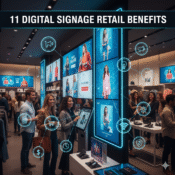
How Does Digital Signage Enhance Knowledge Management?
In today’s information-driven world, knowledge management (KM) is the backbone of organizational success. It involves capturing, distributing, and effectively using knowledge to improve decision-making, innovation, and efficiency. Alongside, digital signage has emerged as a powerful communication tool that bridges gaps in corporate communication and information sharing.
By integrating digital signage into knowledge management systems, organizations can deliver real-time updates, streamline knowledge sharing, and foster collaboration across departments and geographies. This article explores in depth how digital signage enhances knowledge management, its core features, practical applications, and future trends.
Why Digital Signage is Crucial for Knowledge Management
The role of digital signage in organizations has evolved from simple displays to an intelligent communication medium that aligns closely with KM goals.
The Evolving Role of Digital Signage
Traditionally, knowledge management relied heavily on intranets, newsletters, and emails. While effective to a degree, these methods often failed to ensure real-time visibility and engagement. Digital signage has filled this gap, offering a visual, dynamic, and interactive way of sharing critical knowledge instantly.
Key Benefits for Knowledge Management
- Real-time updates: Immediate dissemination of policy changes, compliance information, or operational alerts.
- Accessibility: Ensures information reaches employees across offices, departments, or even remote sites.
- Engagement: Visual and interactive content improves retention and encourages employees to act on the information.
Impact on Retention and Collaboration
According to communication studies, people retain information better when it is presented visually. Digital signage transforms dry text into engaging, multimedia-driven experiences that boost retention and spark collaboration among teams.
Core Features of Digital Signage for Knowledge Sharing
Real-time Communication of Critical Information
Organizations can instantly broadcast urgent announcements, compliance alerts, or performance metrics across screens to ensure everyone is informed simultaneously.
Centralized and Streamlined Information Sharing
A single content management system (CMS) allows knowledge administrators to update displays across multiple locations, maintaining consistency and accuracy.
Interactive and Multimedia Content Delivery
Digital signage supports videos, infographics, dashboards, and interactive touchscreens, making knowledge more engaging and easier to absorb.
Targeted Messaging for Different Audiences and Departments
Segmented communication ensures that employees in different roles or departments see only the most relevant updates.
Integration with Existing Knowledge Management Systems
Modern digital signage platforms integrate with databases, CRMs, ERPs, and LMSs, enabling automated knowledge updates and reducing manual effort.
How Digital Signage Improves Knowledge Management Processes
Enhancing Internal Communication Flow
Digital signage strengthens communication channels across distributed teams, ensuring vital knowledge is not buried in lengthy emails or forgotten intranet posts.
Facilitating Faster Decision-Making
By displaying real-time dashboards and data visualizations, decision-makers gain quicker access to actionable insights, reducing delays.
Supporting Employee Training and Continuous Learning
Screens can deliver training modules, microlearning content, and skill refreshers that employees can consume on demand.
Boosting Collaboration
Project updates, team achievements, and shared resources displayed on digital signage encourage collective effort and knowledge exchange.
Improving Knowledge Retention
The use of dynamic visuals, animations, and interactive content helps employees absorb and retain knowledge far more effectively than static documents.
Practical Applications in Various Industries
Corporate Environments
- Sharing company news, KPIs, compliance rules, and internal policy updates.
- Recognizing employee achievements and reinforcing organizational culture.
Education Sector
- Delivering announcements, lesson highlights, and interactive training materials.
- Centralized updates across campuses to improve knowledge flow.
Healthcare
- Broadcasting real-time safety alerts, treatment protocols, and patient-care guidelines.
- Providing staff with instant updates on compliance and operational changes.
Retail and Hospitality
- Training employees on product knowledge and customer service practices.
- Sharing operational updates to improve consistency in service delivery.
Key Benefits of Digital Signage in Knowledge Management
- Increased Engagement: Consistent, visually appealing content drives higher attention and retention.
- Faster Access to Critical Knowledge: Cuts down communication delays that can lead to errors.
- Collaboration Culture: Encourages sharing, transparency, and teamwork.
- Transparency and Visibility: Makes organizational data and insights visible to all levels of staff.
- Cost Efficiency: Reduces reliance on printed materials, emails, and repetitive training sessions.
Challenges and Considerations
While digital signage brings clear advantages, organizations should also plan for potential challenges.
- Security and Privacy: Safeguarding sensitive knowledge is essential to avoid breaches.
- Content Accuracy: Outdated information undermines trust; continuous monitoring is critical.
- Strategic Alignment: Content must align with organizational knowledge goals.
- User Adoption: Some employees may resist; training and gradual integration can ease the transition.
Future Trends in Digital Signage and Knowledge Management Integration
- AI-Driven Signage: Intelligent systems that adapt content based on audience, time, or context.
- Deeper Enterprise Integration: Connecting with ERP, CRM, and LMS platforms for seamless updates.
- Analytics and Optimization: Measuring engagement to refine knowledge-sharing strategies.
- Mobile and Remote Access: Extending digital signage content to smartphones and laptops for hybrid workplaces.
Conclusion
Digital signage is transforming knowledge management by making information accessible, engaging, and actionable. From real-time updates to immersive training modules, it supports communication, collaboration, and continuous learning across industries.
Organizations that integrate digital signage into their knowledge management strategies will not only improve decision-making and efficiency but also build a culture of transparency and collaboration. The future promises even greater opportunities with AI, analytics, and mobile integration—making now the ideal time to invest in digital signage for knowledge sharing.
FAQs
How does digital signage improve employee training and development?
By delivering engaging multimedia content, microlearning modules, and interactive training experiences that improve retention and accessibility.
Is digital signage secure for sharing confidential knowledge?
Yes, with the right encryption, access control, and data security protocols, organizations can safely use digital signage for sensitive information.
What features should organizations look for in digital signage solutions for knowledge management?
Look for real-time content management, integration with existing enterprise systems, interactive features, and analytics to track engagement.
Which industries benefit most from digital signage in knowledge management?
Corporate enterprises, education, healthcare, retail, and hospitality gain the most from enhanced communication, training, and operational knowledge sharing.



